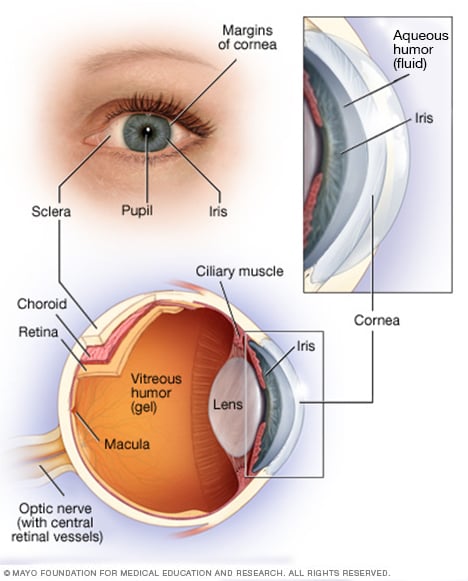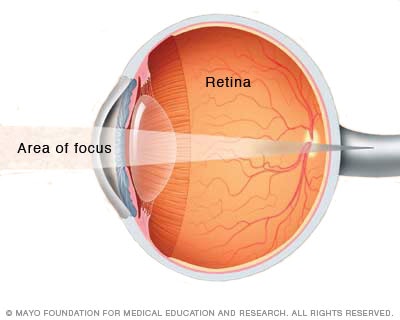Overview
Farsightedness (hyperopia) is a common vision condition in which you can see distant objects clearly, but objects nearby may be blurry.
The degree of your farsightedness influences your focusing ability. People with severe farsightedness may be able to clearly see only objects a great distance away, while those with mild farsightedness may be able to clearly see objects that are closer.
Farsightedness usually is present at birth and tends to run in families. You can easily correct this condition with eyeglasses or contact lenses. Another treatment option is surgery.
Symptoms
Farsightedness may mean:
- Nearby objects may appear blurry
- You need to squint to see clearly
- You have eyestrain, including burning eyes, and aching in or around the eyes
- You have general eye discomfort or a headache after doing close tasks, such as reading, writing, computer work or drawing, for a time
When to see a doctor
If your degree of farsightedness is pronounced enough that you can't perform a task as well as you wish, or if your quality of vision detracts from your enjoyment of activities, see an eye doctor. He or she can determine the degree of your farsightedness and advise you of options to correct your vision.
Since it may not always be readily apparent that you're having trouble with your vision, the American Academy of Ophthalmology recommends the following intervals for regular eye exams:
Adults
If you're at high risk of certain eye diseases, such as glaucoma, get a dilated eye exam every one to two years, starting at age 40.
If you don't wear glasses or contacts, have no symptoms of eye trouble, and are at a low risk of developing eye diseases, such as glaucoma, get an eye exam at the following intervals:
- An initial exam at 40
- Every two to four years between ages 40 and 54
- Every one to three years between ages 55 and 64
- Every one to two years beginning at age 65
If you wear glasses or contacts or you have a health condition that affects the eyes, such as diabetes, you'll likely need to have your eyes checked regularly. Ask your eye doctor how frequently you need to schedule your appointments. But, if you notice problems with your vision, schedule an appointment with your eye doctor as soon as possible, even if you've recently had an eye exam. Blurred vision, for example, may suggest you need a prescription change, or it could be a sign of another problem.
Children and adolescents
Children need to be screened for eye disease and have their vision tested by a pediatrician, an ophthalmologist, an optometrist or another trained screener at the following ages and intervals.
- Age 6 months
- Age 3 years
- Before first grade and every two years during school years, at well-child visits, or through school or public screenings
Causes
Anatomy of the eye

Anatomy of the eye
Your eye is a complex and compact structure measuring about 1 inch (2.5 centimeters) in diameter. It receives millions of pieces of information about the outside world, which are quickly processed by your brain.
Farsightedness (hyperopia)

Farsightedness (hyperopia)
With typical vision, an image is sharply focused onto the surface of the retina. In farsightedness, the point of focus falls behind the retina, making close-up objects appear blurry.
Your eye has two parts that focus images:
- The cornea is the clear, dome-shaped front surface of your eye.
- The lens is a clear structure about the size and shape of an M&M's candy.
In a normally shaped eye, each of these focusing elements has a perfectly smooth curvature, like the surface of a marble. A cornea and lens with such curvature bend (refract) all incoming light to make a sharply focused image directly on the retina, at the back of your eye.
A refractive error
If your cornea or lens isn't evenly and smoothly curved, light rays aren't refracted properly, and you have a refractive error.
Farsightedness occurs when your eyeball is shorter than normal or your cornea is curved too little. The effect is the opposite of nearsightedness.
Other refractive errors
In addition to farsightedness, other refractive errors include:
- Nearsightedness (myopia). Nearsightedness usually occurs when your eyeball is longer than normal or your cornea is curved too steeply. Instead of being focused precisely on your retina, light is focused in front of your retina, resulting in a blurry appearance for distant objects.
- Astigmatism. This occurs when your cornea or lens is curved more steeply in one direction than it is in another. Uncorrected astigmatism blurs your vision.
Complications
Farsightedness can be associated with several problems, such as:
- Crossed eyes. Some children with farsightedness may develop crossed eyes. Specially designed eyeglasses that correct for part or all of the farsightedness may treat this problem.
- Reduced quality of life. With uncorrected farsightedness, you might not be able to perform a task as well as you wish. And your limited vision may detract from your enjoyment of day-to-day activities.
- Eyestrain. Uncorrected farsightedness may cause you to squint or strain your eyes to maintain focus. This can lead to eyestrain and headaches.
- Impaired safety. Your own safety and that of others may be jeopardized if you have an uncorrected vision problem. This could be especially serious if you are driving a car or operating heavy equipment.
- Financial burden. The cost of corrective lenses, eye exams and medical treatments can add up, especially with a chronic condition such as farsightedness.